
Common Types of Dental Bridges
Dental bridges fill gaps in your smile, improve chewing and pronunciation, and prevent surrounding teeth from shifting to fill the empty space. They also prevent gum deterioration, which could lead to tooth decay and jawbone deterioration.
The most common type of dental bridge consists of a pontic (false replacement tooth) anchored with metal wings to two healthy adjacent teeth that are modified for crowns. This is called a traditional dental bridge.
Traditional Bridge
Traditional fixed bridges use natural teeth on both sides of a missing tooth as anchor crowns, with artificial teeth (pontics) in between. They are most commonly used in the back of the mouth because they are strong enough to replace molars.
Dental bridges can improve chewing comfort by redistributing the normal biting forces that are compromised due to missing teeth. However, they require a commitment to attentive oral care. If a bridge is not properly cleaned it may decay the adjacent natural teeth, or the cement can fail and cause problems.
The downside of this type of restoration is that a small amount of enamel must be removed from the adjacent teeth to prepare them for crowns. This can lead to sensitivity and can cause the adjacent teeth to change position, or “lean” into the gap over time. This can result in the need for a full bridge replacement, or other treatment options. Cantilever bridges deviate from the traditional style by using a single anchor tooth.
Cantilever Bridge
Like traditional bridges, cantilever bridges use an artificial tooth called a pontic to fill a missing gap. However, they differ in that they do not require support from healthy teeth on both sides of the empty space, which can save some patients time and money.
In addition, cantilever bridges are less invasive and reversible, which means that they cause less disturbance of the surrounding natural teeth and soft tissues. This makes them especially useful for replacing missing front teeth, as they are able to blend in seamlessly with the rest of the smile.
They can also prevent neighboring teeth from shifting into the gap, which can result in dental crowding, decay, and gum disease. As with all restorations, however, cantilever bridges need to be cared for properly in order to last as long as possible, including daily brushing and flossing. They also need to be protected from excess stress, as they have a greater risk of failing when the pontic experiences an increased amount of pressure than that of the abutment teeth.
Maryland Bridge
Maryland bridges use healthy, adjacent teeth to hold the pontic (fake tooth) in place. Instead of prepping those abutting teeth and fitting them with crowns like traditional or cantilever bridges, a metal “wing” is bonded to the backside of these teeth.
This structure makes it ideal for replacing a single front tooth. It also tends to be less invasive than other bridges and can be completed in just a few dental appointments.
Unfortunately, this type of bridge can be susceptible to debonding, primarily due to the mechanical stresses they endure when chewing and biting. This is why it’s important to maintain a rigorous oral hygiene routine of twice-daily brushing, daily flossing and interdental cleaning using an applicator or water pick. If you do experience issues with your Maryland bridge, consult with a Dentist for an evaluation and repair. Metal is commonly used for these structures, although porcelain has been a common alternative in recent years.
Composite Bridge
A composite bridge is similar to a fixed bridge but does not require the abutment teeth on either end of the bridge to be prepared with crowns. This type of bridge is usually bonded to existing anchor teeth that have been roughened with a chemical to allow for the bonding process.
The resulting structure is less expensive than a porcelain bridge and does not require propping the adjacent teeth. It is also lighter and is more likely to avoid corrosion of the anchor teeth than a traditional bridge.
This technique is especially useful for treating a fractured tooth, as it does not require extensive preparation of the abutment teeth (like an FDP or implant) and can often be accomplished in a single visit. Moreover, this treatment preserves the abutment teeth by conserving their hard tissue. This is beneficial from the standpoint of both preserving the dental hard tissues for future treatments and achieving favorable esthetics with a natural feeling in the tooth [1].


